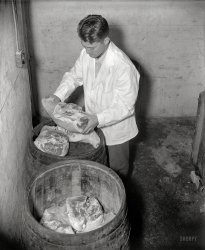
MAY CONTAIN NUTS

Search Shorpy
SHORPY ART

Framed or unframed, desk size to sofa size, printed by us in Arizona and Alabama since 2007. Explore now.
Join and Share
Ad-Free Shorpy
Shorpy is funded by you. Patreon contributors get an ad-free experience.
Learn more.

Recent comments
- Wait a minute ...
- Joad on the Road
- Street Lights Survive
- Now & then
- More or Less? It's a lot less
- A new image.
- Same ol' story ...
- $13,589,422,507.55 in 2024 dollar$
- Skinned knuckles
- Not enough
- Completed, and then enlarged
- Awnings
- 500 West Madison Street
- On this site
- Knowing Time
- Combine Norma Desmond with Ingrid Bergman
- Railroad Time(s)
- And you thought Coca-Cola had a unique additive ...
- Truck Noir
- Wow ... I can’t believe it.
- More better views
- RE: Only one windshield wiper
- Workhorses of my childhood
- Only one windshield wiper
- Drivers
- Mack EQ
- A Bogart film
- Where is It?
- Could that be a Fruehauf trailer?
- Tale of Two Clubs
Member Photos
The Shorpy
Printporium
Printporium
Search Shorpy
Search results -- 30 results per page
- Easy Driver: 1937
- 1937. "Woman demonstrating remote-control 'Safety Shift' gear lever in 1938 ... Offers "Safety Shift" From the Nov. 17, 1937, Milwaukee Journal .
Safety -- 1937 An ignition lock strong enough to hold keys.
No air bag on the ... Posted by Dave - 01/31/2015 - 5:25am -
![Easy Driver: 1937 1937. "Woman demonstrating remote-control 'Safety Shift' gear lever in 1938 Pontiac sedan." Adding another page to our excruciatingly detailed visual record of early Pontiac marketing in the Bay Area. 8x10 acetate negative. View full size.
I Love the Banjo Wheelthe photo makes it appear to ba a nifty butterscotch color!
Pontiac Offers "Safety Shift"From the Nov. 17, 1937, Milwaukee Journal.
Safety -- 1937An ignition lock strong enough to hold keys.
No air bag on the steering wheel to explode with shrapnel.
No floor mat to jam the accelerator pedal.
[In 1937, there were fourteen motor-vehicle fatalities for every 100 million miles traveled by car in the United States. In 2013, one person died for every 100 million miles traveled. So in the 1937 car, on 1937 roads, you are 14 times as likely to die. -Dave]
Three on the treeThe "safety shift" is what those of us old enough to remember called "three on the tree". I would debate the "safety" aspect of this shifter. The last one I drove (in a ~1975 Chevy truck we had at the Parks and Rec. department) worked fine most of the time. But they were fairly notorious for the mechanism in the shift lever end getting hopelessly stuck in an intermediate state where it couldn't be moved without getting out and yanking on the levers at the transmission end. Coasting to a stop in the middle of the road while furiously and usually futilely trying to get it back into gear is not what I consider safe!
Safety step #1Get some different shoes.
At Long Last, Room!With the centrally mounted floor shifter's elimination came a new generation of middle-front-seat passengers: those whose knees remained unbruised by rapid gear changes.
Back to the FutureAbove the ignition key and below the Pontiac logo on the dashboard there appears to be a clock face that could pass for a GPS screen.
Separate Ignition/door keyIt's been quite a few years since the last time I had a GM car with the Square top ignition key and the round top door key (was probably my '82 Buick Regal).
Brett is not the only one.When I took drivers' training in the summer of '64, the local high school had a fleet of Valiant automatics, and one '61 full-sized Plymouth beater with three-on-the-tree. Since I was the only student in class with a manual transmission vehicle at home (Ma's '62 Falcon - she refused to drive an automatic), I got the bulk of the seat time in this lumbering lump. There was a two-foot length of broom handle on the floor of the instructor's side, which Mr. Wing would use to "massage" the transmission hump, thus encouraging it to shift when the linkage hung up on me.
"Column Shift" was not unique to Pontiac that year.It was also used on the 1938 Cadillac 60 Special I owned back in the day (1948). Never had a shifting problem with it. Gone but sure not forgotten.
Floor switchI'll bet that at least some of the Shorpy readers don't remember that, long before the column-mounted device, the headlight dimmer was controlled by a high/low push button on the floor, just to the left of the clutch pedal!
Starter switchThe switch on the floor is almost certainly not the dimmer, but the starter switch. You turned on the ignition with the key, then stepped on the starter switch to switch the starter motor on and turn the engine over.
[It's the headlight switch. Below, an illustration from the 1938 Pontiac owners manual (Spanish edition). "Foot switch for lamps." - Dave]
Definitely the dimmer switch in the imageThe first car I remember that my parents owned was a 1940 Chevrolet. It had two floor mounted switches. The dimmer switch as shown in the post but it also had a floor mounted starter switch that, if my memory is correct was located to the right side of the gas pedal.
With the floor mounted starter switch location near the center of the car it was a relatively short cable run to the starter for the high current load and it probably also was used to mechanically engaged the starter motor to the flywheel. (I am guessing about that last part since I was a little too young to understand the concept of how it operated)
Looks like a floor dimmer to me...While I'm sure some of the older cars may have had a floor switch to start the car, that sure looks like the dimmer switch I had in my '61 and '51 Cadillacs.
(The Gallery, Cars, Trucks, Buses, San Francisco)](https://www.shorpy.com/files/images/SHORPY-207-01.thumbnail.jpg)
- Vagabonds: 1937
- Washington, D.C. June 4, 1937. "Trailer camp." Harris & Ewing takes us into the late 1930s with a ... gizmos involved. Looks like a Dodge.
I was born in 1937 and look forward to more pictures of my parents' world at the time.
... etc. There were over 2000 trailer manufacturers in 1937. Pierce Arrow made a few hundred of them in the late thirties, and even ... Posted by Dave - 07/12/2014 - 2:18pm -
![Vagabonds: 1937 Washington, D.C. June 4, 1937. "Trailer camp." Harris & Ewing takes us into the late 1930s with a "new" batch of 1,945 glass negatives. View full size.
Parade flagCurious flag mounted on the fender, could it have been required when pulling a trailer?
The Good Old DaysWhen a stubborn car could be cured with the tools you could cram into your back pocket and there were no electronic gizmos involved. Looks like a Dodge.
I was born in 1937and look forward to more pictures of my parents' world at the time.
Too many moving partsWhat my father and his friends always said about the latest newfangled washing machines. Is the father in this picture secretly wishing for the simplicity of his old Model T, with no water pump, distributor, generator, battery, starter, gas gauge or roll-up windows to worry about? Or is he glad these conveniences have been brought to a reliable state of mass production as he teaches his son the finer points of adjustment?
Cool ShortsNot often Shorpy shows clothing that fits today's style.
The kid's shorts would fit perfectly today. Correct length and all. But not his shoes. Not by a longshot.
Don't Look Like VagabondsAn orchard in the background suggests a labor camp but the travel trailer and the car suggest a vacation of sorts, maybe a "working" vacation.
The trailer looks almost new, no dents, broken glass, windows open, roof vent operational ana d the car looks to be in good shape, too. The bottom of the spare tire shows road dirt but this doesn't strike me as a "Grapes of Wrath" type migration. hey, is that a radio antenna sticking out of the top of the trailer?
["Vagabond," in addition to meaning wanderer, was a brand of travel trailer as well as the name of countless motels. - Dave]
Plugged InThere seems to be an electric light with a shade and an empty light cord comming down from somewhere out of sight from the top of the picture.
Grapes, UpgradedSeems straight out of "The Grapes of Wrath," though these folks seems a little better off.
Trailer CampThe trailer looks like it's plugged into electric and there's an electric light hanging overhead - Grapes of Wrath this is not.
Curious Flag... That's a fender marker. So you could see where the edge of your fender was while parking and not bash it all up. The other side should have one, too.
1931 De VauxThe car is a 1931 De Vaux 6-75 sedan, made by the De Vaux-Hall Motors Corporation. It was the brainchild of Norman de Vaux, who had on-again off-again ties with General Motors and built the Chevrolet and non-GM Durant factories in Oakland, California. Starting at $595, the De Vaux was an inexpensive assembled car – that is, it was put together with parts from different manufacturers. The car bodies were leftover 1930 Durants with different fenders, hood and grill – all made by the Hayes Body Corporation in Grand Rapids, Michigan. The engines at first were a 65 hp design by Elbert J. Hall, who had co-designed the Liberty engine of WWI fame and co-founded the Hall-Scott Motor Car Company in Berkeley, California. That is the engine in the picture and it was capable of moving the car along at 70 - 80 miles per hour. Later Continental supplied four and six cylinder engines, as they did for Durant, Peerless, Jordan and many other makes.
De Vaux-Hall Motors acquired the Durant factory in Oakland as well as a factory in Grand Rapids leased from the Hayes Body Corporation, and began building De Vaux automobiles in both places. Unable to keep up with sudden demand, De Vaux-Hall only produced 4,808 vehicles in 13 months before they sold to Continental Motors Corporation in 1932. Continental reportedly produced another 4,200 cars called the Continental De Vaux before discontinuing production in 1934. Norman de Vaux repurchased the assets in hopes of restarting production, but in 1936 finally sold the Oakland factory to GM.
There are some 23 Oakland built and around 32 Grand Rapids built De Vaux automobiles still surviving today.
As far as the travel trailer goes, it is the ubiquitous “bread loaf” shape made by numerous manufacturers in the 1930’s including Roycraft, Schult, Kozy Coach, Glider, etc. There were over 2000 trailer manufacturers in 1937. Pierce Arrow made a few hundred of them in the late thirties, and even the Hayes Body Corporation manufactured a similar style. Plus there were dozens of do-it-yourself plans available for the handyman. My best guess is that this is most likely a mid-thirties Silver Dome Hyway model.
ContrastInteresting modern electrical connections to the trailer contrasted with the befringed pull-down shade on the driver-side car window.
Caravan park all rightThe crud on the spare was most likely thrown up from the front wheel. The name "HALL"appears to be embossed on the engine block. Would that indicate what make of car it is?
What's the make ...of the car? The engine block has the word "HALL" cast into the side.
110V of Fine Livin'It looks like the light is plugged/spliced into the top of the trailer.
The trailerWhat kind of material is the trailer made of, I wonder?
Old travel trailersWhat would the external walls of the travel trailer in this photo be made of? It looks sort of like fiberglass although I figure it would be much too early for that. It does have a pattern on it.
[Painted aluminum would be my guess. - Dave]
Fairly well offThis family seems to have fared quite well through the Depression. They look well dressed and the man sports "romeros," slip-on shoes popular until the 1950's. The car and trailer both look well maintained. It appears another member of the family or a neighbor friend is coming around the front of the trailer. For most of 1941, our family of four lived in a 19-foot trailer similar to this, with two doors on the curb-side.
Hall-ScottTwo talented young Californians, Elbert J. Hall and Bert C. Scott, founded the legendary Hall-Scott engine company by producing gasoline powered rail cars. The duo then went on to build motor cars from 1910 to 1921 before moving on to aircraft and marine engines, where the enjoyed their greatest success.
In WWI they produced a family of engines for the “Liberty Motor” program. The engines shared the same cylinder dimensions in 4, 6, 8 and 12 cylinders, with interchangeable parts, designed to be mass produced. No matter the size engine, these low RPM engines were reliable and light weight, producing a very favorable power to weight ratio. Hall-Scott engines were among the best known in aviation history.
After WWI, Hall-Scott left their leadership role in the aviation market to turn to producing engines for trucks, buses, boats and power units.
American Car and Foundry bought Hall-Scott in 1925. ACF used Hall-Scott's fame to advertise their buses as being Hall-Scott powered. They refused to sell engines to others. ACF made an exception for International trucks. The Internationals sported Hall-Scott engines in the 1920s and early 1930s. The engines ran vertically or horizontally, on LPG or gasoline.
deVauxWow! Good answer! Thanks
Trailer CampingTrailer camping was a new phenomenon in the 1930s: it was accompanied by great speculation, and also fear, as to how this would reshape the housing, labor, and tourist economies. The immediate pragmatic concern in D.C. appears to have been issues related to hygiene and sanitation.
Based on other photographs in this series at the LOC showing the proximity of the Washington Monument (will we see them Dave?), my hunch is that this photo is at the Washington Tourist Camp, located "on the bank of the historic Potomac River, and in the midst of the rare and magnificent Japanese cherry trees."
Washington Post, Jul 6, 1937
Hopes Appear Dim for D.C. Trailer Camp
Only 25 Auto Nomads in Potomac Park During Fourth.
Although prospects for a District trailer camp do not appear any too bright for him, Assistant Corporation Counsel Edward W. Thomas will call a meeting of the Washington trailer committee, sometime this week, he said last night.
"Private property for a trailer camp would be pretty high and most other land around here is already in the national park system. But we will meet to discuss trailer health and traffic problems."
The committee was appointed in February by Commissioner George E. Allen to make a study of the trailer situation. Due to activity of District officials at the Capitol during the past few months, no meeting has been held.
In the meantime - as the touring season reaches its peak - there are at least two schools of thought concerning the need for a trailer camp. Less than 25 trailers were parked in the Washington Tourist Camp over the holidays. Some of their occupants expressed opinion that if the District provided a special camp "there would be 500 trailers here every night."
Knode Among Doubters
J.S. Knode, manager of the tourist camp, is among those who have their doubts about that and who wonder whether the economist was right when he predicted that a big portion of the American public would be living on wheels within the next decade.
There is rarely a time when the Knode camp could not accommodate a trailer or two more. The only "homes on wheels" he turns away regularly, he said, are ones bearing District license plates.
"Strangely enough, we are always turning them away. We're just for tourists, but it's hard for them to realize it, apparently."
Washington offers no inducements for touring nomads who wish to settle down for two or three months as they do in Florida during the winter. The tourist camps place a two-week limit on their stay, and it is rare that health regulations can be met when the trailer is parked on private property.
"Gypsy Law" Broken.
Under an old "gypsy law," any vehicle used as living quarters can not be parked on any lot for more than 24 hours unless water and sanitary facilities are provided.
Another hindrance that Thomas considers might stand in the way of a special trailer camp is the District building regulation that requires all new structures to be made of masonry. Trailers have but little brick and mortar in their construction.
Takoma Park, Md., officials last month had to "declare war" on trailers which were parked in violation of the gypsy law. They reported last night, however, the situation was corrected easily and that several trailers are now "hitched up" in that vicinity.
At the tourist camp in East Potomac Park it was evident that trailering soon settles down to a routine just like any other type of travel. Nobody appeared to be much concerned with what the neighbors were doing, or even conscious of the State printed on their license tags. As isolated as if they lived in adjoining apartments some of the nomads sat on doorsteps to read their evening papers - apparently unaware of children who tried to shoot firecrackers in the wet "backyards."
Camping and trailersIn 1954 I took our family of five to see D.C. We stayed in a tent at a campground near the Jefferson Memorial. We had all our camp gear in the 14 ft. boat we trailered on our vacations. This same trip we took the kids to see the Statue of Liberty. In Manhattan, I got in trouble for having a car and trailer on Riverside Drive. We used the boat when we camped at Fish Lake in upstate New York.
Our trailer looked like the one here. I had to report back to the 20th Armored Division in California. Hearing there was a shortage of housing at the base near Lompoc, we bought a trailer in Detroit and towed it west. This was wartime and we had many flat tires. But we got there and sold the trailer when we left California for home.
Vintage TrailerI love seeing photos of vintage trailers. I camp nearly every weekend with my family in our Airstream trailer. It's neat seeing how others fared back before trailers were outfitted with mind-boggling luxuries such as satellite systems, minibars, TVs and so on.
This photo was taken shortly after Wally Byam introduced the first Airstream trailer model, the Airstream Clipper. Interestingly enough, Airstream was the only trailer manufacturer to survive the Depression.
Something about 1930s trailersIn those days practically all trailers were made of wood and covered with Masonite. This was surprisingly durable when painted, they lasted at least 10 years. Much longer if painted or kept under cover.
A few examples of Masonite trailers survive from the 30s and 40s.
More expensive models had a special leatherette material over the Masonite. This may be what is on the trailer in the picture.
The roof was also made of Masonite. It was covered with canvas over a layer of cotton padding then the canvas was sealed with 2 coats of special paint.
In the picture you can see how the edge of the roof canvas is tacked down over the padding.
The most expensive trailers were covered with sheet aluminum. But this did not get popular until after WW2 when better, cheaper, and thinner aluminum became available.
The electrical socket on the roof is a bit of an optical illusion. It is a light socket hanging in the air. Look to the right and you can see a light fixture shaped like an inverted bowl. There must have been a row of these lights suspended from a horizontal wire .
The trailer looks brand new, the car would have been about 5 years old.
There were many brands of trailer that looked like that. If you wanted to pin down the exact brand you could compare to the advertisements and pictures at Atlas Mobile Home Museum website. They have the largest collection on the net.
(The Gallery, Camping, Cars, Trucks, Buses, D.C., Harris + Ewing)](https://www.shorpy.com/files/images/22815a.thumbnail.jpg)
- Cheers: 1937
- September 1937. Craigville, Minnesota. "Saturday night in a saloon." Medium format ... Posted by Dave - 07/19/2012 - 10:17pm -
![Cheers: 1937 September 1937. Craigville, Minnesota. "Saturday night in a saloon." Medium format negative by Russell Lee, Farm Security Administration. View full size.
White gasKerosene lanterns had just an open flame. These pictured were fueled by white gas and the tank had to be pressurized with a hand pump.
Hands-Off policyInteresting that the "Cheers" folks removed the fellow's hand from the lady's shoulder.
Indoor campingPretty rustic. The lights are kerosene lanterns.
Slim pickin'sA James M. Cain novel is written all over that woman's face.
P.A.Do you have Prince Albert in a sign?
Cheers...... it ain't....
Cheers!Hey! Doesn't the guy holding glass appear in the old lead-in for "Cheers"?
Cheers to you too!Oh my gawd it's the folks from the "Cheers!" intro. I must have seen their colorized faces a thousand times (thanks to reruns), and now I know where they're from.
It's like running into long-lost family members. Thanks Dave!
Where everybody knows your nameThis photo was used in the opening sequence of "Cheers." As I remember, it was cropped, to highlight the couple in the center.
0:43Character actorsCentral Casting, eat your heart out!
Cheers!Remember the opening titles to the TV show "Cheers"? It shows old photos of people at bars. One of the "Cheers" photos is THIS photo; they did a close-up of the guy on the left. And yes, I watch too much TV.
Casting? Sure ...That's Howard Hughes, Patricia Neal, and G.W. Bailey on the right. Can't quite make out the lady on the far left, though.
A certain dignity.Even though these people have seen more than their fair share of hard times, there is a kind of dignity in the way the hold their drinks. Serious drinkers for sure. The guy on the right looks kind of like George Clooney. They all exhibit character with a capital C. The guy on the left is giving a major superiority pose to the guy taking a nip.
The lantern in the back corneris a Coleman. I have one just like it. Still works very well.
A rose is a rose is a rose.A barfly is a barfly is a barfly. Nice hat on the alcoholic on the extreme right, looks like he stole it from a horse. Not politically correct but my opinion.
GaslightNotice the fixture in the upper left of the photo is providing light via gas, not electricity.
[As noted below, that's a kerosene lantern. The tank holds the fuel. - Dave]
CamelsAnd I'm thinking that's a Camel cigarette pack on the bar. Recognize the "pillars" from my father's smokes.
That's where I've seem him!Thanks everyone for restoring my sanity. I saw the guy on the left and immediately thought "were have I seen him before?"
I am a child of the 80's so that's why his face was burned into my brain.
Camels for sureI used to smoke them before Pall Mall. Cigarettes didn't have filters in those days. Maybe it was the "Hits or Cracks" game that made me switch from Camels to Pall Mall. As I remember, you guessed if it was the letter H or C under the stamp. If you picked wrong you got slugged on the upper arm.
Alternate casting suggestionsLeft to right: Rosie O'Donnell, Robert Ryan, Margaret Hamilton, Walter Huston. Whatever is transpiring, it's interesting enough for the Missus to delay her request to "light me."
SimplicityThe beer looks great.
Camel Caravan"Camel" was the first nationally advertised and distributed brand of American cigarettes, beginning in about 1914. My dad's first real job was with their NY Distributor, Metropolitan Tobacco, back in 1921. He smoked Camels and only Camels for the nexr 65 years, and never had so much as a cough ("Not a Cough in a Carload"). Back in my time, if I ran out of my favorite, Lucky Strike, I'm bum a Camel from him. Without any exception, they were the strongest, looseest and hottest burning American cigarette that ever existed. They would have killed me after a year! And yes, I do also remember the H and C thing from under the revenue stamp on the packages.
LanternsActually both lanterns are probably Colemans. The one over the bar is an indoor table lamp, which would have originally come with a shade, much like an electric table lamp. The other one is an outdoor type lantern. Both are missing their globes, a rather alarming fact, as the furring strips on the ceiling suggest that it is made of combustible fiberboard, a cheap and popular building material at that time.
Like most Colemans, these burned "white gas," which I believe is actually naphtha, but kerosene models were also available. More common kerosene lanterns have wicks, but pressurized ones do exist. They can be distinguished from the white gas version by the primer cup below the mantle. You fill this cup with alcohol to preheat the kerosene; otherwise, it does not vaporize properly.
BTW, "not a cough in a carload" was the slogan of Lucky Strike, not Camel. And I don't believe for a second that anyone smoked any brand for 65 years without coughing.
Lumberjack TownSome history on this town, and this saloon can be found here:
http://www.lakesnwoods.com/Craig.htm
This place was evidently both a saloon and a barbershop. There are some photos here of other customers, as well as another shot of these folks.
Another image in original Cheers Theme SequenceThe original Cheers Theme Sequence has a picture of my Great-Grandfather W.T. Price II in the Horseshoe Saloon in Junction City, Kansas taken in 1905 by a photographer named Pennell!
(The Gallery, Eateries & Bars, Russell Lee)](https://www.shorpy.com/files/images/8b19903u.thumbnail.jpg)
- Shawneetown: 1937
- April 1937. "U.S. post office. Shawneetown, Illinois." Medium format negative by ... The village was devastated by the Ohio River flood of 1937. The village's population was moved several miles inland to New ... inundated when the Ohio River flooded at the beginning of 1937. Most of the town was moved to a safer location a few miles further from ... Posted by Dave - 05/23/2018 - 11:18pm -
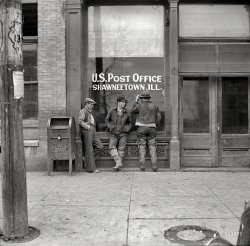
- Family Cart: 1937
- April 1937. "Scene in Shawneetown, Illinois." Medium format nitrate negative by ... that is sweaty can take a long time to dry out.
After 1937 Ohio River Flood Shawneetown was devastated by the Ohio River Flood of January/February 1937. Apparently, the Resettlement Administration was documenting the ... Posted by Dave - 10/05/2015 - 9:35am -
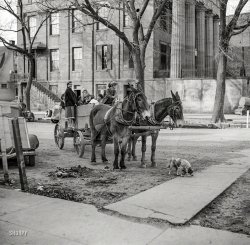
- Royal Furniture: 1937
- New Orleans circa 1937. "842 Royal Street, Sign." Among the highlights: interesting period ... doorway to greet your customers.
American Picker c. 1937 Ohhh, wouldn't you love to get your hands on some of that 1937 New Orleans bric-a-brac? Most shops like this today have had their ... Posted by Dave - 07/19/2012 - 4:37pm -
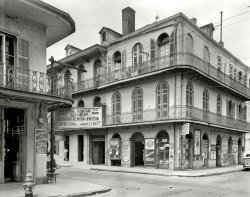
- Organ Transplant: 1937
- February 1937. "An organ deposited by the flood on a farm near Mount Vernon, Indiana." ... born in Mount Vernon, Indiana, in 1939, and my brother in 1937. We always heard about the flood of 1937, and I have a bunch of the family photo albums showing many flood ... Posted by Dave - 09/08/2011 - 10:31pm -
![Organ Transplant: 1937 February 1937. "An organ deposited by the flood on a farm near Mount Vernon, Indiana." View full size. 5x7 safety negative by Russell Lee for the FSA.
Mount Vernon FloodWow! That took me back. I was born in Mount Vernon, Indiana, in 1939, and my brother in 1937. We always heard about the flood of 1937, and I have a bunch of the family photo albums showing many flood pictures. Thanks!
[You're welcome. I guess Mount Vernon was more Vernon than Mount. - Dave]
Mount Vernon 1937 FloodThere is a marker downtown in Mount Vernon that shows were the water came to. The Flood never made it above 3rd Street except in the basements. Mount Vernon is more Mount than Vernon, because unlike Evansville, there was not a major displacement of people and it was treated as something for the kids to see, going down to the river. Most of the flood photos are from the flood plain west and south of the town, where there was no Mount.
Organ transplantIt looks remarkably like the Hamilton organ I've got here in my flat in London. Age unknown. It seems that the Hamilton Organ company packed up in 1920, though the parent Baldwin piano company has staggered through various ups and downs.
Mine still works, after repairs to the bellows, cleaning the reeds and emptying years of cigarette ash out of it.
The one in the photo looks a slightly cheaper model. It has two fewer stops (probably the bass and treble couplers) and there's no sign of the knee bars to operate the swell dampers.
There's a restored 1895 Hamilton illustrated here.
(The Gallery, Agriculture, Curiosities, Russell Lee)](https://www.shorpy.com/files/images/8c51155u.thumbnail.jpg)
- Neideffer Camp: 1937
- Spring 1937. "This family without food and work about to be returned to Oklahoma by ... View full size.
Southern California 1937 My parents and maternal grandparents moved to Los Angeles in May 1937 from their home in Independence, Missouri. A skilled finish carpenter, ... Posted by Dave - 06/17/2014 - 6:07am -
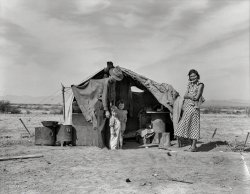
- Louisiana: 1937
- July 1937. "Louisiana Negress." View full size. Medium-format nitrate negative ... and parasol, with her crisp pinner apron!
Louisiana: 1937 Another wonderful photo Dave. New screensaver...
Nice. Una foto ... Posted by Dave - 05/08/2013 - 11:12am -
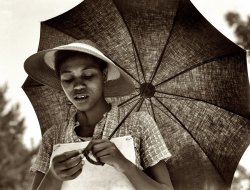
- Dark Passage: 1937
- Chatham County, Georgia, circa 1937. "Stoddard's Lower Range from Factory [Factors] Walk, River Street, ... the cotton factors (brokers) of the era
Dark Passage: 1937: Still the same. I don't spend much time near the river anymore due to ... Posted by Dave - 08/30/2012 - 11:02am -
![Dark Passage: 1937 Chatham County, Georgia, circa 1937. "Stoddard's Lower Range from Factory [Factors] Walk, River Street, Savannah." Passage through the cotton warehouses built by John Stoddard on the bluffs above the Savannah River in the late 1850s. 8x10 inch safety negative by Frances Benjamin Johnston. View full size.
And here it is todayView Larger Map
ClassyI like it. Even utilitarian columns had some class.
It's Factors WalkThat strip is called Factors Walk, after the cotton factors (brokers) of the era
Dark Passage: 1937: Still the same.I don't spend much time near the river anymore due to the tourist influx, but I can assure you it is almost still the same. You can walk through to the other side and stand below Factors Row. Whenever I get to go home it is nice to see things have stayed the same.
+73Below is the same perspective of the Drayton Street Ramp from July of 2010. The top of the passage was created by the construction in 1887 of the Old Cotton Exchange Building utilizing air rights above the ramp (the Cotton Exchange Building fronts on Bay Street). The left side of the passage was enclosed some time ago.
(The Gallery, F.B. Johnston, Factories, Savannah)](https://www.shorpy.com/files/images/00863u.thumbnail.jpg)
- Between Bureaucracies: 1937
- Washington, D.C., circa 1937. "U.S. Labor Department and Interstate Commerce Commission Building. ... cortege down Constitution Avenue to the Capitol.
Late 1937, I think The very new-looking car is a 1938 Studebaker President coupe ... Posted by Dave - 04/11/2016 - 11:56am -
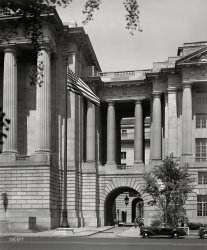
- The Joy of Cooking: 1937
- September 1937. "Wife of John Holling, member of the Otsego Forest Products Cooperative. ... she looks positively ebullient.
Farm of John Holling 1937 Lovely setting. Lots of work outside the house too. Photo could have ... Posted by Dave - 02/22/2017 - 7:37pm -
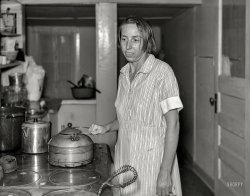
- Hop In: 1937
- ... of 35mm negatives taken by John Vachon in the fall of 1937 in Annapolis, Maryland, and Newport News, Virginia. The car, a Cord ... Wikipedia:
Supercharging was made available on the 1937 812 model. Supercharged 812 models were distinguished from the normally ... Posted by Dave - 06/06/2012 - 5:39am -
![Hop In: 1937 Uncaptioned photo from a batch of 35mm negatives taken by John Vachon in the fall of 1937 in Annapolis, Maryland, and Newport News, Virginia. The car, a Cord convertible, would be worth around a zillion bucks today. View full size.
Suped-upAh, the Cord convertible. In "Anybody Can Do Anything," a sequel to "The Egg and I," Betty MacDonald writes about the cream-colored Cord convertible her brother owned, and how the family would go for rides on weekends until they couldn't afford the gas. Then the Cord became part of an intricate series of trades that I think ended up with him acquiring a house.
I found this interesting, from Wikipedia:
Supercharging was made available on the 1937 812 model. Supercharged 812 models were distinguished from the normally aspirated 812s by the brilliant chrome-plated external exhaust pipes mounted on each side of the hood and grill. With supercharging, horsepower was raised to 170.
It was too late to save Cord, but the contraction "Suped" (referring its supercharged engine) lived on in American lexicon as the hot-rodding phrase "Suped-Up."
[To be taken with a grain of salt. The expression is "souped up" -- for which Webster's gives an entirely different derivation. - Dave]
A Gazillion Equals $75,0001937 Cord 812 Convertible
Must be that "new math"It seems that $75K only gets you the original steel body, with all mechanicals replaced with modern equipment. A complete original will go well into 7 figures. There's a nice original yellow '37 here in my hometown that I see at the post office or court house now and again, owned by a local retired grocer (who owns more than 60 cars of similar caliber).
Another pricey car I see frequently is a '37 Auburn boattail convertible used as a daily driver by a retired auto dealer. (I'd hate to see his insurance bill). Our smirking driver here is no more attractive than the grocer's daughter whom I dated in high school, with a face too high a price to pay daily for a chance to inherit even that collection.
$185kThere is a nicely restored '37 Cord Phaeton currently in Hemmings for $185k.
http://www.hemmings.com/classifieds/dealer/cord/810/1412757.html
Thought balloon"That's right, my car is better than yours."
Of course,it's not a doozy!
Tom Mix had oneA nice supercharged 37 went for 130k at last fall's auction in Hershey. I believe it was a former AACA winner from the 70's, but still a 90+ point car on the CCCA scale.
Tom Mix had one of these and it still exists and has been restored.
Front Wheel DriveOne of the most important features of this car is the front wheel drive. It is one of the few front wheel drive American cars made before WWII that were produced in any appreciable quantity (1,146 in 1937).
The Cord 812s with superchargers are even rarer (less than 200 built over two years).
Cost in 1937 was $2,560. Prices today vary depending on condition, originality, presence of a supercharger, provenance, options, etc., but expect to pay $200,000 - $275,000 for a supercharged exampled in very good condition.
InsuranceOldFogie wonders below about insurance premiums. One of my colleagues restored Studebakers. I asked him about insurance, and he said it was quite reasonable. The impression I got is that insurance companies figure collectors/restorers are good risks.
Can any of you more knowledgeable guys/gals chime in on this?
A first and a last.This car was noted for being an early front wheel drive vehicle but it was also one of the last cars to be designed entirely by one man. Gordon Buehrig was the designer's name. He was also responsible for Auburn's boat tail speedster and many other notable design concepts.
And blinking headlamps, too.Aside from the front wheel drive, another innovation is the disappearing headlamps. Geo might have a point about insurance for collectors as good risks. I pay $56 a month, full coverage, for a fleet of vintage Jaguars and one vintage Cadillac (no accidents, ever). Most I know pay far more for a single car. But I'm betting insurance on a real classic *driven as a daily driver* would be considerably higher than for one infrequently driven (a point my insurance agent checks annually with odometer readings). Quotes for my insurance varied by a factor of 20.
Timeless beauty The 810/812 series Cords replaced the disastrous L29s. Errett Lobban Cord wanted a car bearing his name. Front wheel drive. On the cheap. Thus, it was decided the straight eight Auburn motor would be used in order to save the R and D costs associated with a new engine. The result was that the normal front to rear sequence of engine, transmission and differential was simply reversed in the L29. From the front it became differential, transmission, and the very long straight eight. The car was engineered by the one and only Harry Miller, and design was under the supervision of Auburn chief designer Al Leamy. Industrial designer Brooks Stevens worked up a stunning one off L29. Functionally the cars were a disaster, as the long wheelbase put very little weight over the front drive wheels. Uphill movement, especially in the rain, became hazardous because there was so little traction. The wheels would slip, and frequently ignore any attempt at turning. The model lasted two years, I believe. By the time the beautiful Buehrig ‘coffin nose’ masterpiece came to market, engineered and designed to perfection, it was too late. The depression pretty much did the car and the Auburn, Cord Duesenberg Company in. I understand Cord was in England settled in for the long haul, as the Securities and Exchange folk wanted to talk with him. Buehrig eventually ended up at Ford, where he had a hand in designing the lovely 56 Lincoln Mark II, among other cars. It’s a rare ‘most beautiful cars ever’ list one will see that doesn’t include the Cord 810/812s. They’re timeless.
InsuranceCollector Car insurance is pretty reasonably priced (compared to the value of the vehicle). It's generally based upon very limited street usage, with severe limits to the number of miles that the car can be driven. Unfortunately, things like Cords tend to mostly be trailer queens these days, with the majority of their miles put on during tours before or after car shows. (Thus speaketh the car show judge)
Old Car InsuranceTo chime in on this subject, most collectable and antique vehicles (25 yrs. old and older) are insured by companies that specialize in this coverage. They agree on a stated value, and limit annual mileage to 2500 miles (this may vary depending on the insurer). This coverage will not allow the vehicle to be a daily driver, just what would be considered normal driving to car shows, swap meets, cruise nights, and the occasional spin around town. Because of these restrictions, the cost of insurance is very reasonable. As OldFogie noted, driving one of these classics "every day" is a different story. You would have to find a mainstream company to agree to a stated value and then pay through the nose, I'm sure!
So he was an artistRE: "Buehrig eventually ended up at Ford, where he had a hand in designing the lovely 56 Lincoln Mark II" -- interesting point I did not know. I liked that Lincoln, and only that Lincoln. It seemed rather out in left field compared to Ford's other production. His hand in it explains that anomaly.
Stars with CordsThere's a much circulated Internet photo of the happily-married Hollywood stars Joan Blondell & Dick Powell in their Cord convertible, taken about 1937 looking both glamorous & prosperous. Also, cowboy star Tom Mix met his untimely demise speeding through Arizona while driving his Cord convertible in 1940, when an unsecured heavy metal suitcase slammed into the back of his head. TM's restored car survives and was recently featured in an Antique Automobile Club magazine article.
Auburn-Cord-Duesenberg FestivalBorn in Motown, having a father that loved autos and then living in South Bend, Indiana from 1970-79 afforded my family the opportunity to visit Auburn during the Labor Day weekend "Auburn-Cord-Duesenberg Festival" in its infancy in the early 70s when I was about 10 or 11.
My dad's territory (he was a salesman for Belknap Hardware, a Louisville-based hardware wholesaler) was northern Indiana and SW Michigan and had heard through the grapevine about a classic car festival and auction at Auburn High School. We were off!
The museum is a wonderful tribute to art deco architecture and for anyone passing through Fort Wayne or with an appreciation for the classics, this is a must see. Though I would highly recommend attending during the Labor Day weekend. Studebaker was but a distant memory for South Bend even in the 70s.
We moved back to Detroit in the 80s and visited Auburn during the festival a few times since. It has grown considerably in size and attendance and a few years ago went through tough times with the auctioneer being accused of not paying sellers after their vehicles sold.
Auburn is where dad taught his daughter true appreciation for--and identification of--the classics. My favorite is indeed the Auburn Boattail Speedster!
Invitation to the pastIt's as if this lady is beckoning us to come back in time and take a ride in this classic car. The chrome is pristine, the paint glows. The leather is soft and supple. The finely tuned engine purrs with restrained power. Take a ride and relish an era before plastics and electronics rob us of the soul of the machine.
(The Gallery, Cars, Trucks, Buses, John Vachon)](https://www.shorpy.com/files/images/SHORPY_8a02921a.thumbnail.jpg)
- Scouting Outing: 1937
- May 1937. "Boy Scout Jamboree. Boy Scouts sightseeing on Capitol Transit buses." ... of water available on that sightseeing trip.
The 1937 US national jamboree was the first to be held; the first scheduled was for ... about 30 yards off the river on the Virginia side.
1937 World Jamboree a few months later, in summer time the 5th World ... Posted by Dave - 08/13/2013 - 4:34pm -
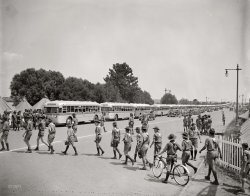
- Smell the Ham: 1937
- College Park, Maryland, 1937. "Hams. The finished products. Miss Ruby Bresnahan, coed at the ... hand - quickly OR slowly aged. A tragedy, I'm sure.
1937 Pickup Line "Hey baby, wanna come over and smell my ham?"
The ... Posted by Dave - 08/28/2012 - 1:41pm -
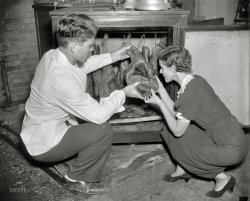
- Flying Wedge: 1937
- August 28, 1937. Washington, D.C. "Washington Redskins start training. He-man exercise ... crime, and skydiver. This he-man exercise looks like a 1937 version of what we now call a trust fall. I wonder if the spectators were ... Posted by Dave - 02/11/2024 - 4:29pm -
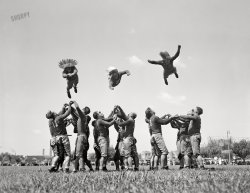
- The Fed: 1937
- Washington, D.C., circa 1937. "Federal Reserve Building, Constitution Avenue. Front and right side." ... Posted by Dave - 02/14/2024 - 12:53pm -
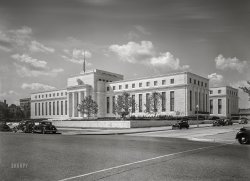
- Made for Walkin': 1937
- June 16, 1937. "Walk 800 miles to attend Boy Scout Jamboree. Two Venezuelan Boy Scouts, ... it would take 800 days to travel. Also Jan, 1935 to Jun, 1937 is a little over 800 days.
[Hm. Might want to check your math, Levi. ...
Descansar A few numbers: Jan 11, 1935 to Jun 16, 1937 is 886 days which works out to an average of about 9 miles per day for a ... Posted by Dave - 08/27/2012 - 7:10pm -
![Made for Walkin': 1937 June 16, 1937. "Walk 800 miles to attend Boy Scout Jamboree. Two Venezuelan Boy Scouts, Rafael Angel Petit, left, and Juan Carmona, examining their boots after tramping 25 miles a day for two years in order to attend the Boy Scout Jamboree in Washington. They left Caracas Jan. 11, 1935, arriving in Washington today." Harris & Ewing Collection glass negative. View full size.
A math problem800 divided by 25 is only 32 days. Either they walked 8,000 miles, or they only walked one day every three weeks or so.
[A news item in the Washington Post (which gave Rafael's last name as Betit) didn't say anything about mileage, although it noted that the boys planned to make the trip home by air in two and a half days. - Dave]
I want those boots!Does anyone know where to find boots like these? I've been wanting a pair like that for as long as I can remember.
Back in the dayI had lace-up boots like Rafael is wearing. It's just that I wore them with miniskirts, and the farthest I walked in those boots was from the bus stop to my junior high.
Try 800 daysDistance from Caracas to DC is a little over 2000 miles. At 25 miles a day it would take 800 days to travel. Also Jan, 1935 to Jun, 1937 is a little over 800 days.
[Hm. Might want to check your math, Levi. Next! - Dave]
Wow!I bet they had some amazing stories.
DescansarA few numbers: Jan 11, 1935 to Jun 16, 1937 is 886 days which works out to an average of about 9 miles per day for a 8,000 mile trip. That seems reasonable given the following description of hacking through jungles for part of the trip.
Washington Post, Jun 17, 1937
2 Boy Scouts End Long Hike,
Ready to Rest
Pair Finish 8,000-Mile Hegira From
Venezuela to Washington.
Descansar.
In Spanish that means rest, which is what Rafael Angel Petit and Juan Carmona are going to get plenty of, now that they've completed their hike from Caracas, Venezuela, to Washington.
The two Rover Boy Scouts, who had been en route since January 11, 1925, puffed across the Key Bridge a few minutes before noon yesterday to reach the end of a trail that led through snake and malaria-infested jungles, head hunters' camps and brigands' hideouts.
They were greeted near the city's entrance by a reception party of Boy Scout officials, legation attaches and motorcycle police but politely declined an invitation to ride.
"No, thank you," said Juan, 26, and quite handsome with Valentino sideburns, "we've walked every step of the way to this point, except when we crossed rivers on handmade rafts. We want to walk all the way to the Capitol."
At the Capitol were waiting the Venezuelan Minister, Dr. Diogenes Escalante, and Director General Leo S. Rowe, of the Pan-American Union. Much handshaking, newsreel and photograph shooting, more handshaking and South American gesticulating followed.
A few hours later the boys were telling a radio audience what it's like to hoof some 8,000 miles apiece without ennui. (The actual distance may be far less but Rafael and Juan often had to take the long way around, not the crow's route.)
Hardships were plentiful on the trip but the boys arrived fit and sound, save for a few vanishing malaria symptoms. Carmona was hit the worst and, through an interpreter, said he is going to look up a doctor here.
At times the heat was so bad the hikers nearly despaired of continuing. The tropical sun killed a dog companion and another perished of snakebite.
Two thousand miles, or about one-fourth, of their journey was through dense jungles. One of them, the Choco Colombiano separating Panama and Columbia, had never before been traversed by civilized man.
"We had to cut our way through this territory," the scouts said, "with machetes, not being able to take one step forward through unbelievably luxuriant vines, trees, grasses, without first clearing our path.
"We were forced for many miles to lay a constant bridge before us of tree trunks in order to avoid quicksand and quaking marshland. For nearly six months we were wet constantly, as the normally difficult crossing of this jungle was further complicated by our striking it at the rainy season."
Malaria, dampness, snakes, insects and heat plagued them. Often they slept in hammocks swung high about the ground for safety. Usually, however, they made their beds on the earth.
In Panama they were feted by the San Blas Indians who, more often than not, are hostile to strangers. A few of them spoke a Spanish dialect, which helped. The natives gave a banquet in their honor, featured by a beverage called chucula.
"This drink was bad enough by itself," the adventurers said, "but we had to watch the women prepare it, and that nearly finished us. It is made of green plantains, grain and coconut, all chewed up personally by the women, mixed well with saliva and left to ferment."
Juan and Rafael said they had a hard time explaining their way out of the clutches of Honduran bandits, then when they were liberated the police placed them under arrest, until their credentials were verified with the Venezuelan government.
It was pretty discouraging, too, when they arrived at Laredo, Tex., only to be halted because of passport difficulties. The scouts had to walk all the way back to Mexico City to get their entrance papers in order.
The sojourners averaged 25 miles a day, wore out 24 pairs of shoes, and passed through Columbia, Panama, Costa Rica, Nicaragua, Honduras, Guatemala and Mexico.
Carmona and Petit will make their Washington headquarters at the Roosevelt Hotel. This morning they will be received formally at the Pan American Union Building by Dr. Rowe.
Alternate Alliterative Appellation:Sole Searching Scouts?
Big BoysOkay, I get Boy Scouts staring at them. But where the heck did they find the sailor!?
I wonder what these guys did when they grew up. Although they look quite manly already.
Bootsl have a pair that are the same made by Harley Davidson. but if you go on ebay and look up logger boots lm sure you will find what your looking for.
Amazing in any ageThat trek would be no less amazing if it was executed today. The regions through which these men walked are still rife with dangers of the same sort, from isolated tribes to snakes to drug lords to marsh and impenetrable jungle. Very cool! I had to wonder though, how is it they didn't have anything better to do than walk all day? Scouts indeed! Try that on your privileged suburbanite boys today!
Susan >> I had lace-up boots like Rafael is wearing. It's just that I wore them with miniskirts ...
Photos, please!
Musical MomentThis is just before everyone launches into a chorus of "Y.M.C.A.," right?
The Return TripAnybody know how they got home?
Can't imagine the end of the Jamboree a week or so later. Everyone says so long and adios, these fellows look at each other, look southward down the road, then both start crying uncontrollably.
[As noted below, they flew back. - Dave]
What a story!What a story! Thanks to Stanton Square for finding the article. Imagine backtracking from Laredo to Mexico City to fix your passports!
And the sailor looks like he popped right off of a box of Cracker Jack.
Jaguars & BanditsAnother accounting of our young amigos adventure comes to us from the student newspaper of the State Teachers College, La Crosse, Wisconsin.
The Racquet, Dec 5, 1937: Vol 30, No. 8
Venezuela Scout-Head Writes Exciting Letter
Several days ago I received an interesting letter from a young man I met at Washington, D. C., while attending the National Scout Jamboree. This man was Juan Carmona, a scout-master from Caracas, Venezuela, South America, who had hiked with a companion, Rafael Petit of Maracaibo, Venezuela, from Caracas through South America, Central America, Mexico and the Southern part of the United States to Washington. The trip took them two years; they covered over ten thousand miles and each wore out twelve pairs of hiking boots. Three started originally but one turned back.
They went through jungle territory never before seen extensively by white man, some days they were able to make good progress; on others the dense jungle growth and swamp bogs limited them to three miles a day. Poisonous snakes and wild animals forced them to be constantly on guard. At night they had to sleep in trees to escape prowling animals.
Once they were awakened by a scratching sound. As the scratching came closer they both aimed and fired their rifles in the direction of the sound. It was so dark that they were unable to distinguish a thing about them. At the sound of the shots the scratching ceased and something crashed to the ground beneath the tree. Unable to sleep further they waited for daylight, which revealed a large jaguar lying dead at the base of the tree. For three days the dead beast's mate stalked and followed them; one was required to keep guard against attack while the other cut and broke the trail. Finally the animal left and they were free to advance more rapidly.
In the southern part of So. America they were taken captive by savages, the chief of which treated them royally but would not permit them to leave. Finally, he was persuaded to allow them to continue their journey. As they traveled through Central America they were made prisoners of revolutionists (it seems there is always a revolution down there). None of the soldiers could read their letters or credentials and they were kept in prison until the revolutionary general returned, read their identification papers and set them free. In Mexico they were robbed of their rifles and money by bandits but finally after many other interesting and exciting adventures, they crossed the U.S. border and reached Washington, D.C.
They have many valuable stamps, seals, letters, pictures and papers from notables of the various places through which they passed. It took them two days to fly by plane back to Caracas. They crossed territory through which they had passed on their two-year journey.
The letter I received was written in Spanish as Juan does not wish to attempt a letter in English even though he understands, and speaks it. Mr. Lairx helped me to translate the letter.
At the present time Mr. Carmona is writing a book of the experiences and adventures of the trip he made with his companion Petit. Our friendship began at Washington and will be continued through our correspondence. I hope to visit Mr. Carmona some time, and he, in turn, has promised to visit me the next time he comes to the United States. Several scouts of the troop of which I am scoutmaster are establishing correspondence with boys of his troop.
Cracker JackThe sailor standing on the right is actually a Sea Scout, as the Scout badge on his cap testifies. For one so young he certainly does have the air of an old salt.
Mapquest por favor"In the southern part of So. America they were taken captive by savages"... They made a serious wrong turn if they left Venezuela headed to the USA and ended up in the southern part of South America!
[They seem to have roamed a bit before heading north. One news item noted that the Scout Jamboree "was not their original objective." - Dave]
A little more of this storyMy name is Carlos Uzcategui Petit, am a member of the Petit family, the history of this pair of young to mid-30 is worthy of pride and admiration of many generations, but to me that for years was a member of the Scouts Venezuela, I am happy to know that today there are those who somehow remembered this story.
The ThirtiesThey went when the going was good, a better time than now. I once thought the 'thirties were a dull, dishonest decade, but have since come to think better of it. It was a fine time to be young, a world full of wonders and adventures and you could get there on foot. The law was becoming a bother, but not the villain it has since become. And when they went in wild places they were able to go armed: Heaven forfend. And how nice that some of their descendants remain to remember their excellent adventure.
(The Gallery, Boy Scouts, D.C., Harris + Ewing)](https://www.shorpy.com/files/images/22868a.thumbnail.jpg)
- Measurements: 1937
- July 23, 1937. "To enable fathers and mothers to order clothes with the confidence that ... of paying attention to race makes me cringe, because it's 1937, and "paying special attention to racial characteristics" doesn't usually ... Posted by Dave - 09/12/2011 - 7:24pm -
![Measurements: 1937 July 23, 1937. "To enable fathers and mothers to order clothes with the confidence that a size 8 or 10 is all it's supposed to be in length and breadth, the Bureau of Economics, U.S. Department of Agriculture, is leading a project in which colleges and universities will cooperate to discover the clothing dimensions needed by today's children. Special attention is being paid to racial characteristics, as the experts believe that race and neighborhood have something to do with a youngster's size. Dr. Eleanor Hunt, associate anthropometrist, Bureau of Home Economics, is shown training one of the first classes on scientific measurement of the human body." Harris & Ewing Collection glass negative. View full size.
She's measuring what now?!I can hardly comment, I'm snickering too hard!
Nice looking kid -- looks a bit like my dad when he was a kid -- though he would not have held still for that.
15 minutes of fame...followed by 25 years of therapy.
Could be worseIt's certainly an improvement over the days when Sears Roebuck promised a perfect fit if you told them your child's age and "whether large or small of age".
Oh Jeez!So much to be said here...
Measuring UpWow - this is such a striking picture I have a number of reactions -- first, that poor kid probably grew up to be a life model for an art class. He has that "I'm not here" look down very well. The dude smirking on the far right probably never grew up. The calipers and tools of measurement make this all look very scientific, but their stated objective of paying attention to race makes me cringe, because it's 1937, and "paying special attention to racial characteristics" doesn't usually mean something good or kindly intended.
Who stole my nightmareThe scary array of measuring tools, the smirking note-takers, the Dr. Seuss socks -- this is the recurring dream I started having when I was 12!
Stranger than fictionYou can't make a picture like this up.
DaveI think a caption contest here would be a bad idea.
The perfect moment Of all the measurements Dr. Hunt took that day, why did the photographer choose this one as his subject? Makes ya wonder...
Tape Measure v. MicrometerMy boyfriend says he would rather this particular examination require a tape measure than a micrometer.
You boys are all very silly. This is nothing to joke about. It is science and all for the betterment of mankind.
Although isn't her rather unnecessary squinting going to psychologically damage this poor young man? I do hope he was paying this no attention.
Mom was rightabout always wearing clean underwear, just in case of moments like this.
Definitely a government operationIt takes eleven people to measure the dimensions of one boy?
Dr. Hunt... you've got cold hands.
GLTPShe is demonstrating the measurement of width at the level of greatest lateral trochanteric projection.
If it weren't for pioneers like this our kids' pants would not fit so well today.
Modern EvolutionJust yesterday I was reading some fascinating material in the March 2009 issue of Discover Magazine wherein evolutionary developmental biologists believe that an extraordinary number of genetic changes over the past 10,000 years has led to significantly different physical characteristics between different ethnic groups. Thus, the above experts may have been ahead of their time.
Does he measure up ?I think the guy on the right and I are thinking the same thing.
Somewhere in AmericaThere's somebody saying, "Oh my God, that's Great-Grandpa in his undies!"
All science aside - - - -just what the heck IS she measuring, and why???
Say What?I don't even know where to begin commenting on this photo. But oh that poor kid.
Wry smilesTwo of the students, the woman, second to left, and the farthest over guy on the right have both cracked what seem probably inadvertent half smiles, the sort of wry grin you get when you are either standing a bit back from the action and actually observing it, or simply the face of someone who is trying to find humor in what is a bit embarrassing.
The poor kid, enduring this display of himself, being measured no less, at an age when this is probably about to become an issue, looks really mortified and fed up both at once. Of course this was depression era. Perhaps his parents were being given a little stipend for this strange bit of child labor? I hope he was rewarded, because he sure was made a show! He's probably about 72 by now. Let's hope he got over it!
[72? Check your math. - Dave]
Miss Eleanorseems to be getting awfully close to Mr. Johnson!
Fark OffI submit this photograph as the greatest potential Shorpy Farker of all time.
With that in mind, let the pros have at it. Restrained commentary is best for this particular shot. Everyone, please back away from your keyboards...
Doc, I swear I can't stopDoc, I swear I can't stop having this nightmare: I'm in a room full of fully dressed people, and I'm standing there in my underwear, and an old biddy with a caliper is carefully measuring, you know, THERE. It's so real, and it's awful. What could it possibly mean??
OMGThat's certainly the first question I put to the men in my life: "Is your 8 or 10 all it's supposed to be in length and breadth?"
Years of therapy...What a strange picture -- the boy has such a look of miserable endurance. Dr. Hunt is lucky she didn't get kicked in the teeth. The seated woman second from left is the only one looking at the boy with any compassion at all, and even that is ambiguous. Poor kid.
Aw, gee... do I have to, Ma?You've got to believe this kid is hoping the fellas don't find out about this. The gent all the way at the end in the white shirt is perhaps thinking the same thing on the kid's behalf. Love all the clashing patterns on the ladies' dresses.
Caption contest?Oh Dave, there HAS to be a caption contest in THIS image? No?
Warm up your PhotoshopThis cries out to be Farked.
Not with a ten-foot poleEven commenting on this is likely to get you investigated.
Oh, Dang....there's a stain on my sock, and what's all that alcohol for!...Are they going to operate? Yikes!!
Times have changedNowadays you'd have to buy her a drink first.
Strange...Is anyone concerned about the guy on the far right with the creepy smile on his face?
I'm more concernedabout the two guys on the left without writing materials and their arms crossed. Those guys are the pervs.
BTW, there is no way in heck that you could have gotten me to stand there like that.
Figure 8So, he's an 8, right? Oh, I get it -- that's why it says "8" on the back of his hand.
Senseless observationThere is nothing wrong with this situation. I once measured a young woman with a tire pressure gauge and a meat thermometer. Not to mention a decibel meter after Mexican food.
Grandpa trousersHe wore his undies pulled up tight all the way to his belly button, that explains why so many men his age now wear their pants pulled up to their armpits!
This is trulyone of the strangest pictures I've ever seen, on this site or anywhere.
(The Gallery, D.C., Harris + Ewing, Kids)](https://www.shorpy.com/files/images/23082a.thumbnail.jpg)
- Enchanté: 1937
- October 1937. "Family of Joe Kramer, farmer near Williston, North Dakota." Photo by ... Posted by Dave - 07/09/2013 - 6:43pm -
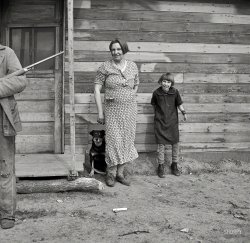
- Bar Mizpah: 1937
- August 1937. "Former bank, now a saloon. Mizpah, Minnesota." Medium format negative by ... Posted by Dave - 01/15/2014 - 1:04pm -
![Bar Mizpah: 1937 August 1937. "Former bank, now a saloon. Mizpah, Minnesota." Medium format negative by Russell Lee for the Farm Security Administration. View full size.
Record breakerMizpah had a population of 56 in the 2010 census. It holds the record for the latest snowfall in the state: an inch and a half on June 4, 1935.
Grain Belt BeersGrain Belt 'Premium', a pretty decent beer, was sold in the bar/restaurant of the old Hector Field airport at Fargo, North Dakota during the 1970s.
Lucky StrikeEndorsing Lucky Strike cigarettes ("It's Toasted!") from beneath the awning is British actress Madeleine Carroll, the cool blonde in Hitchcock's 1935 thriller, "The 39 Steps." In '37, she appeared in three films: "On The Avenue," "It's All Yours," and the superb "The Prisoner of Zenda."
What it isIt's a Cannonball Alarm Company "Bug" bank vault alarm box, as seen here: http://www.flickr.com/photos/43678707@N02/5738392330
You gotta love the internet!
Another GuessThe mystery box could be the exhaust for the vault ventilator. BTW, I liked "Liquid Assets" better but "Bar Mizpah" is pretty darn good too.
Box on the Wall???What is the box on the wall above the awning near the roof line?
I am betting that it is an exterior alarm bell left over from the buildings earlier days as a bank. If not then it appears to contain a giant spider.
Edit...
WOW! Based on betabox's research in his post above I was almost right on both counts. The only difference is his link looks more like a beetle than my giant spider.
Building, built to lastI wonder what its used for these days?
View Larger Map
Architectural DetailsWhat the heck is this.
Excellent business planI reckon nobody ever went broke turning anything into a bar in rural Minnesota.
Mizpah, Minnesota The building, located at 101 Woodland Ave, is currently the home of the Mizpah Post Office. I called them, and the clerk confirmed it.
[Actually, the post office is in a newer building a block and a half north at Woodland and Cedar, as noted in a comment above. -tterrace]
Boy, was I offI thought this was Beerbank, California.
In the backgroundYou see the Chicago, Burlington & Quincy Railroad depot and the tracks. This building is located at the corner of Woodland Ave. & Pleasant St. The Post Office building is at Woodland Ave. & Cedar St.
Not a CB&Q (Burlington Route) depotbut rather Northern Pacific Railroad. (Minnesota & International subsidiary anyway). The "Q" never went anywhere near this far north. Burlington Northern took up the rails here in about 1992 and is probably why someone thought this was former "Burlington".
(The Gallery, Eateries & Bars, Russell Lee, Small Towns)](https://www.shorpy.com/files/images/SHORPY_8b38889u.thumbnail.jpg)
- Tankar Gas: 1937
- December 1937. "Gas station in Minneapolis." The Minnesota tropics, where snow dusts the ... be smaller than what I'm familiar with.
Tag Along 1937 Ford with a Mullins Red Cap trailer.
Frost shields The application ... Medal Flour" sign that's barely visible on the left of the 1937 photograph is a big clue to the location. It's not visible from the ... Posted by Dave - 02/20/2013 - 11:47am -
![Tankar Gas: 1937 December 1937. "Gas station in Minneapolis." The Minnesota tropics, where snow dusts the painted palms. Photo by John Vachon. View full size.
Love the billboardsI found the billboards very interesting. I grew up 40 miles north of Minneapolis. The Minneapolis Journal or Sunday Journal was published until 1939 when it merged with the Minneapolis Star to become the Minneapolis Star-Journal. Other mergers took place and today it's the Star Tribune. The American Weekly was a Sunday Supplement, published by Hearst, inserted into the Sunday Journal. It was published until 1966. The Russell-Miller Milling Company at this time made Occident Flour and was headquartered in Minneapolis. In the early 1950's it become part of the Peavey Co., which in turn was bought by ConAgra in 1982.
Awesome trailerHorace T. Water is correct, this is a 37 Ford (Tudor sedan). I have seen trailers like this, but was under the assumption that they were new "retro" designs, not actual period trailers. I found out that somebody is now making fiberglass reproductions.
The Gold Medal SignIt turns out you can see it in Street View, from 3rd Street at Washington:
Re Frost shieldsHard to tell from the ad davidk provided (or even if that model is what I'm about to describe), but in the mid-30s rectangular defrosters went on the market that were held on the window interior by suction cups. These had exposed thin wires not unlike today's embedded rear window defosters that were electrified either by the car's system or by 6-volt batteries. The ones in the Ford appear to be smaller than what I'm familiar with.
Tag Along1937 Ford with a Mullins Red Cap trailer.
Frost shieldsThe application of frost shields used to be mandatory in Winnipeg on the windshield (unless the car had a defroster), rear window and front-row side windows from November 1 through March 31. The ad below from my hometown paper, the Free Press, is from 1952. There is still a company in Manitoba that manufactures them for use in construction vehicles, helicopters and outbuildings.
Plus 76?After spending far too much time digging, I can offer what might be (approximately) the present-day view, with about 80-90% confidence:
View Larger Map
The "Gold Medal Flour" sign that's barely visible on the left of the 1937 photograph is a big clue to the location. It's not visible from the Street View above due to new construction - but if you back out to the 45 degree view and head about two blocks southeast and one block northeast, you'll see it. It's also hard to tell from the sometimes-grainy Street View magnifications, but I'm fairly certain that the most of the brickwork is the same as 1937, although they did brick in the upstairs area.
[For the depot shed to be on the left as in the 1937 photo, I think we'd need to be a block or two west of 5th Avenue, around 3rd and Washington. The 1940 map below shows the outline of the gas station office facing 3rd, which was a major thoroughfare crossing the Mississippi. - Dave]
[I won't dispute your map, but I have trouble seeing how the Gold Medal Flour sign would be both visible and aligned as it is in the 1937 photo if the camera was that far west. There are also some features of the brickwork, including the distinctive offset about 12 feet up on the left edge, that make me go "hmmm."]
[The sign, atop a six-story flour mill, is visible from most of downtown Minneapolis. Also, our photo was taken from the second floor as opposed to Google's ground-level Street View. Plus that building at 5th and Washington doesn't look anything like the one in our view, in addition to being set back much farther from the curb. It's three stories tall as opposed to the two-story building in the 1937 photo. - Dave]
[I concede. I found a 1937 aerial photo of the area (see below), and the corner of Third and Washington looks far more likely to be the spot than the corner at Fifth. When I'm looking for a historical spot like this, I try not to make any assumptions - such as "in the past 70+ years, they didn't brick in the open second story" or "they didn't build an addition" or "there was no third story hiding behind the billboards" or "that train depot never extended past Fourth Avenue." Now that I have photographic evidence, I'm fine with admitting I was wrong.]
[You can tell there's no third floor just by looking at the photo. The cornice is at the bottom of the billboard. Plus you can see there's nothing behind them through the latticework between them. And in any case they're not tall enough to hide a third floor. - Dave]
[I realize I'm now beating a dead horse, but your last comment makes it sound unreasonable to think there's a third floor. What I see through the latticework is a brick wall (red oval). That wall appears to be supported by a substantial concrete column (green oval) - either that, or this is an Escherian building. That leaves about 10-12 feet of space to be a "third floor" (cyan oval). With some added brick and a few layers of paint, there is no reason this edifice could not resemble what's currently at the corner of Fifth and Washington. (Note that I am not arguing that it is that location (I agree it's at Third), I am simply pointing out that it is perfectly reasonable to think that there is - or could be - a third floor here.)]
OOOH!Free dishes!
Thanks davidkI was just about to ask if anyone knew what that rectangle was on the driver's side window.
I think Dave is correct.The Milwaukee Road train shed ends at 5th Avenue South and Washington. Gold Medal Flour is at about 700 West River Parkway. The gas station would have to be at 3rd or maybe 4th Avenue South. This area on either side of Washington Avenue from Hennepin to 11th Avenue was known as the Gateway district. About 40 blocks were cleared for urban renewal in the 50s and 60s. Only in the last 10 years has the sea of parking lots started to fill in.
One modern convenienceBased on the bare bulb visible through the dirty window, I'm thinking it's not the Ritz Carlton; but somebody in that building has a mighty fine radio antenna on the roof... a fairly long dipole, likely to receive AM broadcasts.
Cut-RateTankar was apparently a low-price chain headquartered in Minneapolis. Some of the stations had old tank cars as part of the architecture.
F.A.P. May Be The Key.The street sign on the left may hold a cryptic key to the puzzle. The sign post clearly indicates one roadway, but at the bottom, facing the camera is a small sign with "F.A.P." or Federal Aid Primary. That sign indicates this road was receiving Federal money as a primary route and would have to be a fairly substantial route. F.A.S. signs for Federal Aid Secondary are sometimes also seen on smaller routes or further out on primary routes that receive less Federal maintenance money. I know nothing about this area, but I hope that little sign now gives you the intersection.
[The sign is pointing you to it -- F.A.P. 92B is to the right. - Dave]
TrainshedWhat may be confusing you is that the Milwaukee Depot Trainshed has been shortened and there are cross streets there now that were not there when the photo was taken at which time it was a active depot.
[The cross streets are the same. This is Third Avenue crossing Washington, in a view seen here two years ago. The clock tower still stands. - Dave]
Re re Frost shieldsNo electricity involved, Don Struke. The classic frost shield is a rectangle of plastic stuck by adhesive at its perimeter to the auto glass. You put them on the inside of the window, and the vacuum created between the plastic shield and the glass kept the window free from condensation and frost. I’ve heard of a fancier kind made of glass with a rubber gasket, but no one I knew used these.
Once when my dad was in the Southern states with his Canadian frost shields on, a gas attendant asked him if it was bullet-proof glass.
Re: TrainshedThe trainshed always ended at 5th Avenue, but the yard continued to Chicago Avenue where a large viaduct took the tracks across Washington. If you look at the aerial photo in Splunge's comment, you can see that the shed ends at 5th, but only Portland Avenue crosses the yard.
Perhaps a chimney?I thought the "substantial concrete column (green oval)" that Splunge mentioned was a chimney for a heater or fireplace in the gas station's office below.
BTW, I don't have any horses to be concerned about, but I do enjoy the friendly banter and explanations offered. Sometimes it's very helpful to see something from another's viewpoint.
Thanx to all that have commented!
TrailerIsn't anybody going to mention that fantastic, streamlined trailer? Homemade or manufactured and its got to belong to that Mark Trail looking guy puffin' on his pipe.
[See the very first comment below. - tterrace]
Miller millingI would expect nothing else.
Along withthe previous busy comments in the scene, note the worst job of bricklaying behind the palm trees, and the Tax Paid sign, AND Glueks Beer on Tap.
3rd and WashingtonThe train shed is the tip-off. If the Google street view were from second story rather than - uh - street level, you could then see the Gold Medal Sign. BTW, the Gold Medal sign has been moved around a bit since 1937 due to a fire at the "A" Mill and restoration of the Mill Ruins Museum.
Tax? Which?I'm still bewildered by the sign "TAX PAID 5 FOR 85"
I've arrived at no meaningful interpretation for that.
Somebody help me out, please.
3rd and WashingtonThis confirms that it was on 3rd and Washington. No doubt that is the Tankar building in a sea of parked cars. How it survived "urban renewal" and the rest of the buildings didn't is beyond me.
TankarLooks like they redid the palm tree mural in the 1940s. The photo below is from the Zalusky Collection.
(The Gallery, Cars, Trucks, Buses, Gas Stations, John Vachon, Minneapolis-St. Paul)](https://www.shorpy.com/files/images/SHORPY_8b29416a.thumbnail.jpg)
- The Tower: 1937
- New Orleans circa 1937. "The Tower, 1015 Chartres Street." 8x10 inch negative by Frances Benjamin ... Posted by Dave - 08/30/2012 - 11:04am -
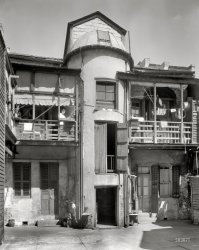
- Liberty Street: 1937
- New Orleans, Louisiana, circa 1937. "Liberty Street cottages." 8x10 inch acetate negative by Frances Benjamin ... Posted by Dave - 08/14/2012 - 3:53pm -
![Liberty Street: 1937 New Orleans, Louisiana, circa 1937. "Liberty Street cottages." 8x10 inch acetate negative by Frances Benjamin Johnston. View full size.
Under the bridgeIf 1010 Liberty still exists, it would just about be under the Pontchartrain Expressway.
Shoe renewalNewly white, drying in the sun.
Step to Rocking ChairEvery time I see small children in these photographs, it make me wish I could have had a nice long talk with the elderly person that child turned out to be. My grandfather died 27 years ago and was born about the time this kid was.
What's in a name?When I close my eyes and envision a "cottage", this ain't it. I do like the wrought iron fence detail to the left, though.
That's a healthy home!Having plenty of "Three Sixes," they never had to worry about colds or malaria.
Ad nauseam: 666All you'd ever want to know about the 666 brand, here, here, here and here. (Scroll down to the comments.)
Empty Shoes #5This may be really silly but I have been keeping track of the Johnston photos with orphan shoes. So far:
1. https://www.shorpy.com/node/8628?size=_original
2. https://www.shorpy.com/node/8615?size=_original
3. https://www.shorpy.com/node/8586?size=_original
4. https://www.shorpy.com/node/8559?size=_original (?)
5. https://www.shorpy.com/node/8783?size=_original
Aye, 'tis a tough job, but somebody has to do it.
He is only 73 years oldThis lonely little fellow could very well still be among us and wouldn't it be amazing if he could reveal himself? After the detective work done by all the viewers of tterrace's advertising photo (which ended up solving ALL the mysteries therein), I'm convinced that the intelligentsia of Shorpy fans can research and find out anything they put their minds to. This is a great photo, very inspirational potential for writing a little story. Thank you Shorpy for giving me a hobby.
[Math check: More like 75. - Dave]
Treme StreetThis was on North Liberty, which was renamed Treme Street. This corner is now vacant, and I think this Creole cottage is gone too. The building with the dormer was a church, now in horrible condition. I think it is due for renovation though. The house right next to it is very nice, and there are many great buildings nearby. Too many blighted ones too.
(The Gallery, F.B. Johnston, Kids, New Orleans)](https://www.shorpy.com/files/images/01297u.thumbnail.jpg)
- Where the Grapefruit Grow: 1937
- January 1937. "Part of the family of a migrant fruit worker from Tennessee, camped ... Posted by Dave - 09/09/2011 - 11:41am -
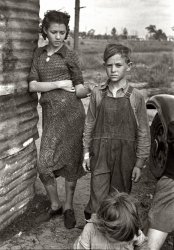
- Aldridge Plantation: 1937
- June 1937. "Wife and child of tractor driver. Aldridge Plantation, Mississippi." ... Posted by Dave - 04/12/2017 - 1:46pm -
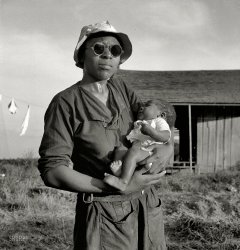
- Future Farmer: 1943
- ... and Alma (Prohl) Janowski, the third of four children. In 1937, the family moved to Loretta, WI and a new home on Blaisdell Lake. Bob ... Posted by Dave - 07/14/2024 - 4:02pm -
![Future Farmer: 1943 February 1943. "Madison, Wisconsin. Farm short course at the University of Wisconsin. Robert A. Janowski, who is eighteen years old and a high school graduate, comes from a sixty-four acre farm of which five acres are cultivated. His father works as an automobile mechanic in Chicago." Acetate negative by Jack Delano for the Office of War Information. View full size.
Shutterfly on the Wall"Bob was an avid photographer his entire life"
Thanks AxelK. I wonder if Bob and Jack discussed photography during their photographic encounter in February 1943.
Not that I'm pickyHe's a handsome young man, setting out to make the world a better place. But my attention keeps drifting up to the War Bonds poster, where two thumbtacks have been removed from the corners (you can see the pin holes), leaving them to curl. And for God's sake -- would someone please fix that curtain rod!
1925-2017A veteran, a fellow of mechanical aptitude, law enforcement officer, and family man, as reported in the Wisconsin State Police Quarterly Alumni Newsletter for December 2017:
Robert A. Janowski Sr., age 92, of Hayward, WI died Friday, October 20, 2017 at Country Terrace in Hayward. Robert Arthur Janowski was born January 10, 1925 in Des Plaines, IL to Stanley and Alma (Prohl) Janowski, the third of four children. In 1937, the family moved to Loretta, WI and a new home on Blaisdell Lake. Bob finished his schooling at the Draper school, graduating from high school in 1942. After high school, Bob worked in Hartland and Oconomowoc. He served in the U.S. Army Air Corps from 1945 to 1946, and after his discharge moved to Milwaukee, where he found employment. He worked at American Motors, Milwaukee Gas Company and Continental Can Company. In 1951, he met Evelyn Spanbauer in Milwaukee and they were married in Rockford, IL on January 5, 1952. They resided in Milwaukee and Grafton, WI until 1961 when Bob joined the Wisconsin State Patrol. They relocated to Beloit, WI and lived there until their retirement in 1982. Bob and Evie then moved to Winter, WI and built a new home on Highway G. Bob was an avid photographer his entire life, as well as a craftsman, building wood furniture including a beautiful pool table for his son.
That's my dadWow, that's my dad as a vintage WWII propaganda image! I've never seen this photograph before but I knew my father attended the farm course at UW Madison.
The biographical information others have posted is correct, and yes, he was a lifelong photographer. I have all of his old photographs (and also a cabinet he built).
I grew up hanging out with him in his woodshop and running away from his camera
because he was always snapping photos of us.
[More photos of Dad here. And here! - Dave]
(The Gallery, Agriculture, Education, Schools, Jack Delano, WW2)](https://www.shorpy.com/files/images/SHORPY-8d14382u.thumbnail.jpg)
- Movie Mecca: 1937
- 1937. Movie theater in Crossville, Tennessee. View full size. 35mm nitrate ...
Inflated Peanuts? Well, after taking each monthly 1937 to 2007 dollar, via the Consumer Price Index site, and averaging them, a 1937 dollar averages $695.23, so a $180 bank account in 1937 would equal ... Posted by Dave - 09/09/2011 - 11:24am -
![Movie Mecca: 1937 1937. Movie theater in Crossville, Tennessee. View full size. 35mm nitrate negative by Ben Shahn for the Farm Security Administration.
Mecca MoneyWow, a $180 bank account! I am going to be there.
Inflated Peanuts?Well, after taking each monthly 1937 to 2007 dollar, via the Consumer Price Index site, and averaging them, a 1937 dollar averages $695.23, so a $180 bank account in 1937 would equal $12,514.14 dollars today. I'd take that!
[According to the CPI Inflation Calculator, a 1937 dollar has the same purchasing power as $14.60 today. So that $180 bank account would be worth $2,628. - Dave]
$180But that's purchasing power...what about savings power? It was a savings account after all.
What would $180 in 1937 be worth 71 years later, if left in a savings account earning interest (and assuming the bank didn't go bust or anything)?
[Compound interest calculator. - Dave]
MeccaWell, hell, if all I had to do was go see a movie with some friends, I'd take the $180 even now. It's a month's gas, water and electric (twice that in summer!), or two months' groceries. For a small theatre as opposed to a major corporation, that's a pretty large giveaway!
Then and NowAccording to my aunt, this theater has been called the Palace for decades. It's been restored and is used for pageants, concerts, etc.
Re: Lobby CardsLooks like the lobby cards are advertising "The 13th Chair," a mystery released in 1937 starring Dame May Whitty, Lewis Stone and Madge Evans.
See here:
http://www.imdb.com/title/tt0029661/
Lobby CardsCan we get a closeup on the lobby cards? Please.
[I'm a sucker for closeup pleading. - Dave]
Not the PalaceThis theater was at the other end of Crossville and the building still stands to this day but was gutted for the LP Shanks warehouse. It closed not long after the Palace opened in 1938.
This is a very cool photo that I've never seen before. THANKS for posting.
BoxesCan anyone make out what the boxes are stacked in front of the grocery on the left-hand side?
[Ball mason jars, for canning fruit and vegetables. - Dave]
(The Gallery, Ben Shahn, Cars, Trucks, Buses, Movies, Small Towns)](https://www.shorpy.com/files/images/8a17078u.thumbnail.jpg)
- Old-Timer: 1937
- April 1937. "Old man on the street in Shawneetown, Illinois." Cornering the market. ... to document the effects of the great Ohio River flood of 1937.
Shell station And it appears there's a Shell gas station across ... ( http://en.wikipedia.org/wiki/Ohio_River_flood_of_1937 ) a few months before the photo was taken, and the entire town was moved ... Posted by Dave - 11/14/2012 - 6:28pm -
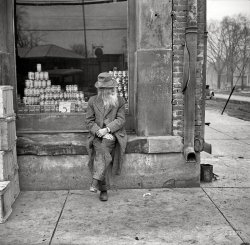
- Pork Barrel Pyrolysis: 1937
- Oct. 27, 1937. College Park, Maryland. "No longer is it necessary to age ham a year or ... Posted by Dave - 07/09/2013 - 8:09am -
